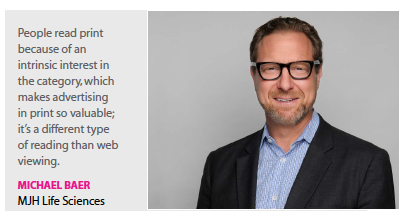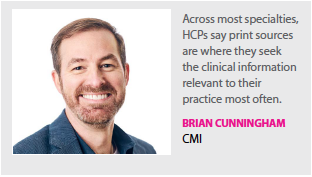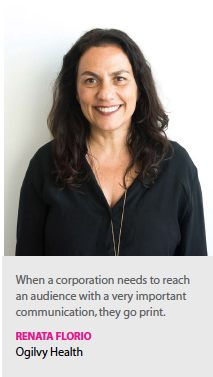The pandemic has increased the use of digital solutions, but print still brings plenty of value to pharma marketing.
For the past three holiday shopping seasons, Amazon, the second-most valuable company in the United States, valued at $1.7 trillion, has issued printed toy catalogs. Why would such a successful e-commerce company based on a digital platform use a print catalog to generate sales?
Because Amazon knows print works.
In healthcare, the industry spend on digital marketing continues to increase, especially under the pressures of the COVID-19 pandemic, but print remains a credible medium for reaching audiences and a valid channel in the media mix toolbox.
 Reports from eMarketer show that spending on digital advertising in the healthcare and pharma industry grew by 14.2% to $9.53 billion in 2020, so there’s no denying digital is on the rise in the industry and elsewhere.
Reports from eMarketer show that spending on digital advertising in the healthcare and pharma industry grew by 14.2% to $9.53 billion in 2020, so there’s no denying digital is on the rise in the industry and elsewhere.
Unlike digital, the value of print lies in its ability to engage and sustain the reader’s attention, its longevity, credibility, and especially for pharma, physicians often prefer print over digital for medical information. Print advertising connects with its audience more on an emotional level than digital does, offering readers a chance to linger over the product and its message in a way that other channels don’t. Some experts say print has become a respite from the constant blink of a screen. Print publications allow for the reader to slow down and enjoy some relaxed browsing of content.
“Print offers a moment or a rest away from one’s computer screen," says Michael Baer, chief marketing officer at MJH Life Sciences. “While people are working from home — and working longer and more hours — they are certainly seeking breaks from screen time."
Renata Florio, chief creative officer at Ogilvy Health, notes that even though digital is on the rise, print maintains its value for the industry.
“I would say that print has more credibility," she says. “When a corporation needs to reach an audience with a very important communication, they go print."
Ms. Florio also believes that print works better for medical education material, and also for content directed toward payers. “When information is needed in a handy format, I think print is still very useful," she says.
 “There is little debate that print’s more tactile delivery lends itself to better connecting the audience to the message," says Brian Cunningham, senior VP, media at CMI. “Print has a built-in opportunity for a more intimate connection. The physical nature of the channel creates a better likelihood of captivating the audience before they have even seen your ad. Marketers can harness that likelihood for a more effective ad in print."
“There is little debate that print’s more tactile delivery lends itself to better connecting the audience to the message," says Brian Cunningham, senior VP, media at CMI. “Print has a built-in opportunity for a more intimate connection. The physical nature of the channel creates a better likelihood of captivating the audience before they have even seen your ad. Marketers can harness that likelihood for a more effective ad in print."
The key, Mr. Cunningham says, is to strike the right balance of stopping and staying power in the creative. Creative imagery and a tagline that grabs an emotion must seamlessly weave into a deeper clinical benefit found in the core message. “Ads that deliver on this balance have the potential to resonate your brand message long after engagement," he says.
While overall print readership may be continuing to decline, those who value print are as loyal as ever to the medium, Mr. Baer says. Nearly two-thirds of print subscribers describe themselves as “primarily print-focused."
 Print audiences tend to concentrate on the information in front of them, as they are not distracted with the pop-ups, notifications, and hyperlinks of the digital world, which can take them to the outer limits of the Internet and away from the intended advertising.
Print audiences tend to concentrate on the information in front of them, as they are not distracted with the pop-ups, notifications, and hyperlinks of the digital world, which can take them to the outer limits of the Internet and away from the intended advertising.
“These are people who are seeking to stay up to date in their fields, and thus are hungry for the content that they’re holding in their hand," Mr. Baer says. “They tend to spend extended periods of time with these publications. They’re more open to viewing what’s surrounding an article that they’re reading, meaning they’re more open to ads, which is, of course, hugely valuable to advertisers.
“Data supports the fact that experts and specialists in their fields view ads in this type of setting almost the same as they do editorial — as content that helps them stay up to date and savvy to what’s going on in their field," he continues. “This consequently makes them more likely to take action on a print ad than online. We’ve seen in reader studies that in some cases more than 40% of consumers said they had taken action from a print ad."
In addition, in an era of disinformation and fake news, print is generally viewed as “real news," according to Mr. Baer. In fact, print is the most trusted advertising channel, with greater than 80% of consumers saying they trust print ads.
“This is why advertisers are really embracing print and using it for long-form content type of stories," Mr. Baer says.
“The big difference between digital and print is print’s long-lasting effect," Ms. Florio says. “Personally, I save magazines, and I can just pick one up anytime and visit for a while. That’s more difficult to do in a digital format. Digital content has its life, but then it’s gone."
Reaching Physicians
Multiple surveys show that print is especially effective in reaching physicians, as many of them prefer print for medical education. Their continuous need for the most up-to-date information keeps them using both traditional and digital channels. The crucial factor is that the message is there when and where they are looking for it, whether it be a website or print vehicle.
CMI/Compas research has shown that HCPs are comfortable with information and data available in many media channels, and are demanding information be accessible when they want it, whether online or in print, at the office or at home.
First and foremost, it’s important to be where your audience is, CMI reports. While this means most campaigns are going to include a mix of digital, print, and other media, it also means that when reaching out to physicians, print must be included.
“When we survey HCPs and consumers on what media most resonates with them, we always see a cross-channel response," Mr. Cunningham says. “Across most specialties, HCPs say print sources are where they seek the clinical information relevant to their practice more often."
CMI/Compas 2018 research focusing on reprints found that HCPs primarily prefer print journals, although digital journals are gaining ground. A more recent CMI/Compas Media Vitals study for 2020 revealed that 87% of HCPs say medical article reprints are somewhat, fairly, or very important for staying up to date on medical developments and treatments and physicians use them mostly for longer-term educational needs (by 50% of HCPs) or non-immediate needs (by 39% of HCPs) rather than immediate needs.
CMI’s 2020/21 Media Vitals research shows that even in a year where digital consumption accelerated for everyone, print ad sources were cited more often across a majority of specialties and primary care as an important source of medical news over their digital equivalent.
However, marketers need to understand the preferences of the individual physicians on their target list and deliver content in the channel most used by those audiences. In the research, 76% of physicians preferred print over 43% who preferred digital.
“Reader studies show that more than nine out of 10 medical and surgical professionals say they read print journals and two-thirds of them say print is important in helping them stay abreast of the new medical developments in their fields," Mr. Baer adds.
 Marketers shouldn’t ignore the new generation of doctors, however, who may prefer digital materials. The onset of COVID has driven digital to its peak, and Ms. Florio wonders what will happen once everyone can safely return to their offices. “Someone has said that we have developed digitally more in the past nine months than we have in the past decades, in terms of how to reach doctors through digital media," she says. “So I’m really curious to see how print will be affected once we can go back to the office."
Marketers shouldn’t ignore the new generation of doctors, however, who may prefer digital materials. The onset of COVID has driven digital to its peak, and Ms. Florio wonders what will happen once everyone can safely return to their offices. “Someone has said that we have developed digitally more in the past nine months than we have in the past decades, in terms of how to reach doctors through digital media," she says. “So I’m really curious to see how print will be affected once we can go back to the office."
It’s the $1 million question of 2020, she says. “If you asked me last year, before COVID, I would have said absolutely print works better to reach doctors, but now in 2020, we’ve learned to develop the same sort of information in a digital manner, so much faster."
Mr. Baer’s company is still using direct mail, because it continues to work well.
“All audiences are definitely using digital more than ever," he says. “But we also know that physicians are very print-centric. Physicians like to read long-form copy and they like to hold a publication in their hand. So, we still do direct mail because we know a lot of our audience picks up and reads printed material."
Elements of a Winning Campaign
Marketing is about reaching your audience in the moments when they are most willing to listen. When considering whether to invest in a print campaign it simply comes down to understanding who the audience is, Mr. Cunningham says.
“If you know the where, when, and how the audience is consuming relevant content or seeking healthcare information, leverage those insights," he says. “Don’t just be somewhere because it is the latest trend. Be where your audience is, whether that is in the more traditional promotional ad spaces, or within the most cutting-edge technology."
Ms. Florio believes beauty, the correct use of media, transparency, and authenticity all build a winning campaign. “Transparency and authenticity are very important," she says.
Ms. Florio calls out Dove’s recent campaign called Courage is Beautiful as an example of a well-executed campaign that has the four elements she highlights. In it, Dove celebrates the strength and determination of frontline workers amid the coronavirus pandemic. The ads show workers as they sport marks on their skin from PPE equipment, alongside the tagline “courage is beautiful." All photos feature real doctors and nurses, who were approached by Ogilvy via Instagram. The campaign was designed by Ogilvy Worldwide, another team under the Ogilvy umbrella, not Ms. Florio’s unit.
“It’s the perfect example, in my opinion, of elegance, beauty, authenticity, transparency," she says.
“It’s super aligned with the brand statement, the core of the brand. For me, it’s a work of art."
Ms. Florio says translating beauty into pharma advertising can take many forms and doesn’t always mean using beautiful models or happy couples.
“The key is in the execution," she says. “There needs to be good photography and good craft. If it’s an illustration, is it the most sophisticated illustration you can do? Or if it’s a picture, is it the best light, the best production, is the wardrobe on point, what does it say about the characters? Pharma ads can look like pharma, they just need be the best of pharma."
Ms. Florio suggests another campaign that works much better in print than it would in digital is the book Blink to Speak, an “eye language" guide created by TBWA/India for the NeuroGen Brain & Spine Institute and the nonprofit Asha Ek Hope Foundation to help people with paralysis communicate. The campaign won the Grand Prix for Good award in 2018. The book teaches nurses and caretakers how to communicate with people who have ALS or other conditions that prevent communication.
It’s a book that shows how to communicate through the eyes, she says. “Closed eyes mean yes, open eyes mean no, etc. There was no other way this could have been done except for in print," Ms. Florio says. “It would not work on a cellphone; it needed to be a large book that nurses and caretakers held to teach patients. It’s really beautiful, heartwarming, wholesome, and effective; it’s print at its best, in my opinion. And on top of that, it is life-changing for the caretakers and the patients."
Another advantage of print advertising is the ability to leverage context especially well. “People come to print because of an intrinsic interest in the category," Mr. Baer says. “This is what makes advertising in print so valuable — it’s a different type of reading/viewing than web viewing."
Mr. Baer adds that it is especially critical that the content of the advertisement fits the context of the editorial copy and even potentially feeds off it.
 “An ad should feel relevant and connected to those users who are in a specific mindset when they’re reading a publication built around an interest of theirs," he says. “The design of the ad should have relevance to the copy to create an immediate understanding or impact. Otherwise, no matter what’s in that long copy, a reader won’t be attracted to find out more or to read that body copy."
“An ad should feel relevant and connected to those users who are in a specific mindset when they’re reading a publication built around an interest of theirs," he says. “The design of the ad should have relevance to the copy to create an immediate understanding or impact. Otherwise, no matter what’s in that long copy, a reader won’t be attracted to find out more or to read that body copy."
Mr. Baer adds that a visual story is important to break through and there has to be enough copy to communicate a believable and credible message.
“There also has to be some type of hook that pulls the audience in," he says. “According to our reader studies, the highest attention-getting ads tend to be good-looking ads with a well-designed layout and a crisp, interesting visual. Additionally, print should connect to the brand’s omni-channel programming, because we’ve seen that print works especially well when part of an overall program."
According to Mr. Cunningham, the most important element is to make sure the print ad is where your audience is.
“If print is the medium your target audience is viewing, then your message needs to be there," he says. “When considering whether to invest in a print campaign it simply comes down to understanding the audience."
In other words, he says, don’t just be somewhere because it is the latest trend.
Marketing is about reaching the audience in the moments when they are most willing to listen. An omnichannel mix that centers around what most resonates with your audience is the best bet.(PV)
~~~~~~~~~~~~~~~~~~~~~~~~~
Four Advantages of Print over Digital Advertising
1. Trust
According to a MarketingSherpa survey, “advertising in newspapers and magazines will tend to add credibility to your product or service."
2. Recall
Readers face fewer distractions with print content. Studies have shown that people are 70% more likely to recall a brand after seeing it in a print ad.
3. Longevity
According to The American Marketing Association, the longer shelf life and higher potential for multiple readers of print beyond the initial reader bring extended value.
4. Engagement
People choose print material because they are interested in its topic. When the ads align with the rest of the content, that adds to the value.
Source: (compiled by PharmaVOICE from various sources)
~~~~~~~~~~~~~~~~~~~~~~~~~
Top Three Pharma Spending on Print, January to June 2020
Genentech: $6.5 million
AstraZeneca: $5.7 million
Pfizer: $5.2 million
Source: Kantar’s Healthcare Print Ad Spend Tracker


















